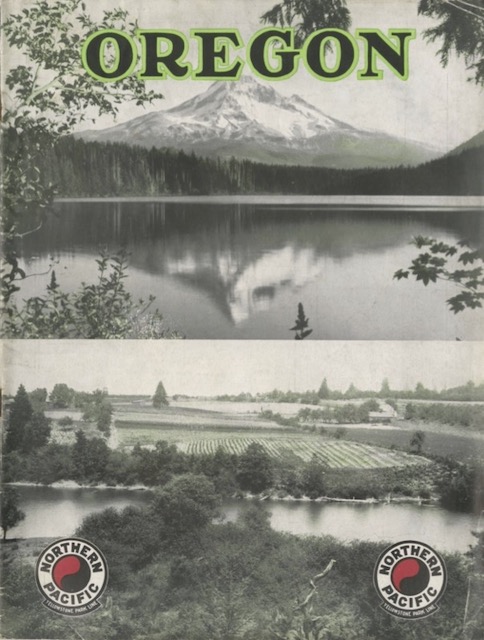We’ve previously seen a 1946 booklet from the Great Northern urging people to resettle in Oregon for their “successful farming future.” Here’s a similar booklet issued by Northern Pacific in 1933 whose front and back covers are adorned with black-and-white photos realistically tinted with green for Oregon fields and forests.
 Click image to download a 23.8-MB PDF of this 40-page booklet.
Click image to download a 23.8-MB PDF of this 40-page booklet.
“Oregon farms are operated amid pleasant surroundings, in quiet valleys near the mountains or near the sea,” says the booklet. “Farming is an occupation which brings one close to nature and in Oregon this fact is magnified be- cause the state abounds in natural wonders” including “salmon and other game fish.” Sadly, farming was one, though certainly not the only, factor that led to the near-demise of salmon and other migratory fish.
The booklet notes that Oregon had 23 million acres of “agricultural land” of which only 16 million were in farms. But the booklet also notes that the state’s farmers grew crops on less than 3 million acres; the rest was range land, which is counted as agricultural land but is rarely as productive. Moreover, most range land was owned by the federal government and not available to new farmers. The booklet could say it was “in farms” because the government gave ranchers leases to graze their livestock on this land — and not many new leases were being granted in 1933.
The Northern Pacific barely entered Oregon, crossing the Columbia River into Portland. However, its half-owned subsidiary, the Spokane, Portland & Seattle Railway, had lines in both northwestern and central Oregon. So naturally the booklet emphasizes the areas served by SP&S lines, while it says very little about far eastern or southwestern Oregon.
The booklet also has two pages about recreation in Oregon, mainly hunting and fishing but also sightseeing. But they are less about “come visit” than about “move here and you can enjoy these recreation opportunities every day.”
